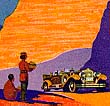

Effortless Admittance
Introduction
Until the late 19th century, much of the Southwest was a mystery to Americans. Rarely did people venture into the remote corners of New Mexico and Arizona territories, which became part of the U.S. in 1848. However, writings by such people as Charles Lummis, Mary Austin, George Wharton James, and others, and representations by artists such as Ernest L. Blumenschein, Bert Geer Phillips, and Oscar E. Berninghaus, began to appear in the late 19th and early 20th centuries. Ethnographic interest in the native peoples had existed since the earlier surveys and military movements which encountered these populations. No longer considered a "vanishing race," Native Americans became mythologized through the popularity of their artwork and culture. The Southwest was compared to the cultures of the Middle East. The spectacularly varied arid landscape, the ruins of ancient cultures, and the ongoing exoticness provided by the indigenous cultures and the Spanish colonial peoples and settlements, made the Southwest an attractive destination.
By 1885, the Atchison, Topeka and Santa Fe Railway had reached the Pacific coast, making the entire continent from the Atlantic by rail. With the invention of the motor car, accessibility to out-of-the-way places from all stopping points along the railway became possible. One of the first entrepreneurs of the southwest was Major R. Hunter Clarkson. His words, "There is more of historic, prehistoric, human and scenic interest ... than in any similar area of the world, not excepting India, Egypt, Europe or Asia.... The big idea is not only to let people know what is in Northern New Mexico but to tell them what it is when they see it," spoken on August 25, 1925 (Thomas, 1978, pp. 52-53). 1990). This heralded the start of the Fred Harvey Company "Grand Tour" era.
These tours, known as Indian Detours and Off the Beaten Path, were chauffeured and guided motor car tours which swept people away from the familiarity of the train into remote places of New Mexico and Arizona. They were offered as side trips on the major routes from the midwest to southern California. Tourists -- called "detourists" and "dudes" -- were met at the railroad stations by women dressed in Southwestern attire and accompanied by a cowboy driven Harvey car (Weigle, 1990). Places such as the Grand Canyon, Rainbow Arch, the Petrified Forest, the Painted Desert and other American Indian lands were on offer for the adventurous and curious, all within the comfort of the motor car!
This section of our display includes samples of the colorful pamphlets
which were circulating in the early part of this century, reminiscent of
these tours. Dating from the 1920s and 1930s, they
emphasize the dramatic landscapes, cultural complexities, and ease of access
that the new routes could offer the traveler.
In order to view the following files you must have an Acrobat Reader.
If you do not possess this software, please consult the
About
the PDF link. To view a larger color image of one page of the pamphlet in JPEG, click on any image thumbnail. To view the whole pamphlet as PDF (color or black-and-white), click on the linked call number next to the thumbnail.
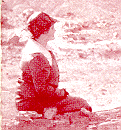 [Atchison, Topeka, and Santa Fe Railway Company]
[Atchison, Topeka, and Santa Fe Railway Company]
Petrified Forest National Monument, Arizona
Chicago: Rand McNally & Company
1923, 15 pages
C9791 Pam. 143 [1.4 MB]
This pamphlet is one of several published between 1905 and 1931 by the Atchison, Topeka and Santa Fe Railroad Company. It is displayed with pertinent text and illustrations for one's enjoyment. The 1923 round trip fare cost from $5.00 per person for the shorter trips to $10.00 for the longer ones.
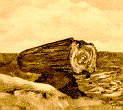 Rainbow Forest Lodge, Adamana, Arizona
Rainbow Forest Lodge, Adamana, Arizona
Petrified Forest National
Monument and Painted Desert, Adamana, Arizona
Brooklyn, N.Y.: The Albertype Company
Circa 1920, 15 pages
C9791 Pam. 196d [2.4 MB]
This pamphlet, published by the Rainbow Lodge, is mostly enhanced with photographs of memorable scenes from the forest and desert. The original is printed in sepia. The selection of images illustrates the variety of the landscape, such as The Snow Lady, The Sphinx, Eagle Rock, Twin Sisters, and an overall view of The Painted Desert.
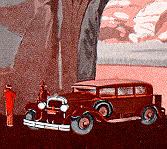 [Atchison, Topeka, and Santa Fe Railway Company]
[Atchison, Topeka, and Santa Fe Railway Company]
Indian-detours: Off the Beaten Path in the Great Southwest
Chicago: Rand McNally & Company
1936, 24 pages
F786 I5 Pam Part 1 [2.2 MB] Part 2 [2.5 MB]
This Indian Detours pamphlet includes descriptions of the tours offered. There are several black and white photographs, some which repeat the previous years' pamphlets. There is general information about the Santa Fe/Courier Car companies and two maps showing tours in New Mexico and the Petrified Forest.
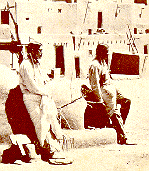 [Atchison, Topeka, and Santa Fe Railway Company]
[Atchison, Topeka, and Santa Fe Railway Company]
Indian-detours: Roundabout Old Santa Fe, New Mexico
[Chicago]: Rand McNally
1940 (reprint), 24 pages
F786 I5 Pam Part 1 [2.1 MB] Part 2 [2.1 MB]
This Indian Detours pamphlet from the Santa Fe Railroad Company describes excursions of varied lengths in and around Santa Fe, all leaving from the renowned Fred Harvey hotel, La Fonda, "The Inn at the End of the Trail." Several full-page black-and-white photographs of the sites to be visited are included. The theme is on the old and exotic, with emphasis on Indian culture.
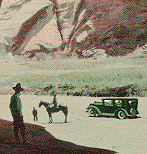 Conoco Travel Bureau
Conoco Travel Bureau
Arizona "The Egypt of America"
Denver: Conoco Travel Bureau
1933, 8 pages
C9791 Pam. 199 [1.8 MB]
This guide to the sites of Arizona was put out by the Conoco Travel Bureau. Its opening lines are designed to draw the reader into the history and culture of the region. Its colorful cover emphasizes two of the unique aspects of the area: the tall red stone cliffs and the Sahuaro cactus. It gives descriptions of the tourist sites, and there are some "color enhanced" as well as black-and-white photographs. One photograph of "An Arizona Residence" is atypically large and classy.
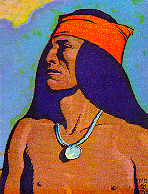 Southern Pacific Company
Southern Pacific Company
Apache Trail
1930, 4 pages
C9791 Pam. 5 [1.2 MB]
This is one of a collection of pamphlets produced by Southern Pacific illustrating their one day trip by motor coach over the Apache Trail. Its attraction is to encourage travelers from New York or Chicago to Los Angeles to take a break from their comfortable train carriage and step out among the Indian ruins of Arizona. The pamphlet is illustrated beautifully in full color showing a picturesque view of the route (we used greyscale). Several covers were used over the years for this same pamphlet, some examples are available here: 1917 Cover [0.6 MB] 1924 Cover [0.7 MB] 1926 Cover [1 MB].
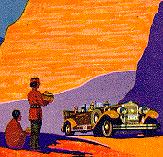 [Atchison, Topeka, and Santa Fe Railway Company]
[Atchison, Topeka, and Santa Fe Railway Company]
Indian-detours: Most distinctive Motor Cruise Service in the World
Chicago: Rand McNally
1930, 64 pages
C9791 Pam. 2 [2.6 MB]
This beautiful color pamphlet was published by the Santa Fe/Harvey Cars companies. The descriptions include the philosophy of and personalities behind these tours, as well as the famous La Fonda hotel. The remainder of the pamphlet describes the various tours that were offered, illustrated with quaint maps of many of the routes and several photographs. We included two of the tours--to Frijole Puye and the Prehistoric Southwest--to whet the appetite for this charming brochure.

Santa Fe Trailways
Grand Canyon and the Indian Empire; Indian Detour and the Grand
Canyon
[Wichita, Kansas: Santa Fe Trailways]
Circa 1940s, 20 pages
C9791 G7 Pam. 19 [3 MB]
A Santa Fe Trailways brochure which invites the traveler into the "land of romance, mystery and beauty." This particular pamphlet, with its colorful exterior, carries the Indian theme throughout with its designs which invite the reader to turn the pages. There are many black-and-white photographs of places to be visited along the Old Historic Santa Fe Trail. Some history is offered, with alluring invitations to indulge in stopovers and side trips. Short descriptions of each of the notable sites are given.
Introduction | Accessibility | Advertising | Agriculture | Architecture | Entertainment | Environment
Exotic | Health | Indigenous Culture | Railroads | Religion | Roads
